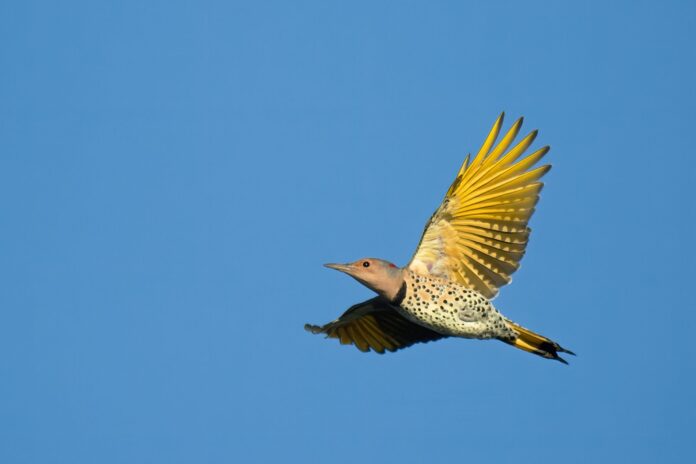AUBURN UNIVERSITY, Ala. – In Alabama, one of the most iconic and historic creatures is the Northern flicker. These distinguished birds are found in forests, neighborhoods and parks across the state–reminding residents of the species’ significant heritage. The Northern flicker, also known as the yellowhammer, has a storied history in Alabama dating back to the Civil War.
History
According to the Alabama Department of Conservation and Natural Resources, the Northern flicker became associated with Alabama after a 19th-century event during the American Civil War.
A company of young calvary soldiers from Huntsville sported vibrant yellow fabric on their uniforms. These features were located on the coattails, collars and sleeves of the soldiers–resembling the Northern flicker. Soldiers from elsewhere noted the similarity, and this group of young men were later given the name yellowhammer company.
Although the flicker was already also known as the yellowhammer by this time, Alabama had not yet become the yellowhammer state. The yellowhammer was officially adopted as Alabama’s state bird in 1927.
Flicker or yellowhammer?
The Norther flicker (Calapates auratus) is a type of woodpecker in the scientific family Picidae. These birds are classified into two groups: yellow-shafted and red-shafted. Birds from either group are nearly identical but have a few distinctions.
Both flickers are barred with black and brown feathers on the back and wings. Each bird also shows a white breast containing black spots and black necklace below the head.
The yellow-shafted flicker is distinguished by a red patch on the neck and a grayish crown (top of the head). However, the giveaway is the bright yellow underwings located beneath the tail. Locally, it is referred to as the yellowhammer because of its tendency to peck or hammer into trees or the ground while showing its yellow under feathers.
The red variety possesses a brown crown and no neck patch. Comparatively, reddish feathers are found under the tail wings. Only the yellow-shafted Northern flicker is found in Alabama.
Wesley Anderson, an Alabama Cooperative Extension System wildlife specialist, explains the key difference between male and female yellow-shafted flickers.
“The male flicker fittingly sports a black mustache while that marking is absent in females,” Anderson said.
Habitat and distribution
Yellow-shafted flickers can be found throughout the eastern United States and as geographically south as Cuba. They can also be found in the Northern climates of Alaska and southern Canada.
Flickers prefer open areas with enough trees and poles for nesting. These locations include woodlands, groves, parks and other suburban areas. Some yellowhammers are even reported to use nesting boxes on occasion.
Biology
The primary meals of choice for the Northern flicker are ants, fruits, berries, seeds and other insects. The key to obtaining food for flickers is their long bill and barbed tongue. Since approximately half of the yellowhammer’s diet is ants, these birds are often seen hammering into colonies to find larvae. This behavior is similar to its woodpecker cousins–using their barbed tongue to grab prey.
“Flickers spend much of their time on the ground while foraging for ants,” Anderson said. “Their behavior is quite atypical compared to our other woodpeckers.”
For those who like to place bird feeders in the spring, flickers will use these structures as well. Yellowhammers like to feed on sunflower seeds, peanuts and suet. To increase the chances a flicker visits a feeder, consider using open tray or suet feeders.
Male flickers lead the charge when determining a nesting site. Ideal spots for nests are typically dead trees, poles or stumps. After the site is chosen, the male burrows into the cavity to excavate–occasionally with some help from the female. This process can take up to four weeks to complete.
Breeding season begins in March and ends as late as mid-July. A litter of eggs or a clutch from a Northern flicker typically contains six to eight eggs but could include as many as 14. Eggs are laid daily and are identified by a glossy, smooth white surface.
The egg incubation period lasts approximately 11 to 13 days. After being cared for by both parents, the nestlings begin moving around the cavity near the three-week mark. Finally, after 25 to 28 days with mom and dad, the young will leave the nest on their own.
Their nests are often later used by other bird species such as eastern bluebirds and small mammals.
More information
The Northern flicker is one of 420 confirmed bird species in Alabama. Each one is unique in its own way and plays a role in the state’s environment and ecology. To learn more about the yellowhammer woodpecker and many other animals in Alabama visit the Alabama Extension website, www.aces.edu.



















